Until that time it was necessary to cross the river in a boat (although it is possible the Romans had a bridge at the same location). The completion of the bridge dramatically increased traffic across the river - and also raised a great deal of money for the local council, who charged a toll for each crossing.
The bridge is built on foundations of oak - great oak trunks up to a metre across were sharpened (like pencils), the pointed ends reinforced with iron straps, and the wooden posts then driven into the river bed. This provided the base on which the stone bridge could then be built.
There is also a chapel on the bridge dating from the 12th century, where the tomb of Bénézet was originally held - the lower part dates from the 15th century.
Frequent damage meant the bridge was often repaired over the following centuries, until finally being abandoned after severe damage in the 17th century.



































































































































































